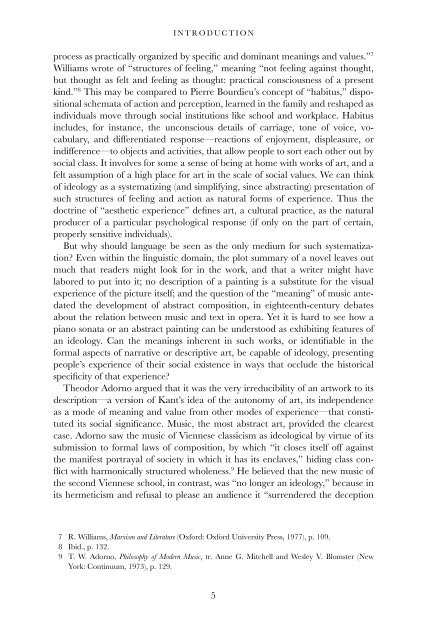Art in its Time: Theories and Practices of Modern Aesthetics
Art in its Time: Theories and Practices of Modern Aesthetics
Art in its Time: Theories and Practices of Modern Aesthetics
Create successful ePaper yourself
Turn your PDF publications into a flip-book with our unique Google optimized e-Paper software.
INTRODUCTION<br />
process as practically organized by specific <strong>and</strong> dom<strong>in</strong>ant mean<strong>in</strong>gs <strong>and</strong> values.” 7<br />
Williams wrote <strong>of</strong> “structures <strong>of</strong> feel<strong>in</strong>g,” mean<strong>in</strong>g “not feel<strong>in</strong>g aga<strong>in</strong>st thought,<br />
but thought as felt <strong>and</strong> feel<strong>in</strong>g as thought: practical consciousness <strong>of</strong> a present<br />
k<strong>in</strong>d.” 8 This may be compared to Pierre Bourdieu’s concept <strong>of</strong> “habitus,” dispositional<br />
schemata <strong>of</strong> action <strong>and</strong> perception, learned <strong>in</strong> the family <strong>and</strong> reshaped as<br />
<strong>in</strong>dividuals move through social <strong>in</strong>stitutions like school <strong>and</strong> workplace. Habitus<br />
<strong>in</strong>cludes, for <strong>in</strong>stance, the unconscious details <strong>of</strong> carriage, tone <strong>of</strong> voice, vocabulary,<br />
<strong>and</strong> differentiated response—reactions <strong>of</strong> enjoyment, displeasure, or<br />
<strong>in</strong>difference—to objects <strong>and</strong> activities, that allow people to sort each other out by<br />
social class. It <strong>in</strong>volves for some a sense <strong>of</strong> be<strong>in</strong>g at home with works <strong>of</strong> art, <strong>and</strong> a<br />
felt assumption <strong>of</strong> a high place for art <strong>in</strong> the scale <strong>of</strong> social values. We can th<strong>in</strong>k<br />
<strong>of</strong> ideology as a systematiz<strong>in</strong>g (<strong>and</strong> simplify<strong>in</strong>g, s<strong>in</strong>ce abstract<strong>in</strong>g) presentation <strong>of</strong><br />
such structures <strong>of</strong> feel<strong>in</strong>g <strong>and</strong> action as natural forms <strong>of</strong> experience. Thus the<br />
doctr<strong>in</strong>e <strong>of</strong> “aesthetic experience” def<strong>in</strong>es art, a cultural practice, as the natural<br />
producer <strong>of</strong> a particular psychological response (if only on the part <strong>of</strong> certa<strong>in</strong>,<br />
properly sensitive <strong>in</strong>dividuals).<br />
But why should language be seen as the only medium for such systematization?<br />
Even with<strong>in</strong> the l<strong>in</strong>guistic doma<strong>in</strong>, the plot summary <strong>of</strong> a novel leaves out<br />
much that readers might look for <strong>in</strong> the work, <strong>and</strong> that a writer might have<br />
labored to put <strong>in</strong>to it; no description <strong>of</strong> a pa<strong>in</strong>t<strong>in</strong>g is a substitute for the visual<br />
experience <strong>of</strong> the picture <strong>its</strong>elf; <strong>and</strong> the question <strong>of</strong> the “mean<strong>in</strong>g” <strong>of</strong> music antedated<br />
the development <strong>of</strong> abstract composition, <strong>in</strong> eighteenth-century debates<br />
about the relation between music <strong>and</strong> text <strong>in</strong> opera. Yet it is hard to see how a<br />
piano sonata or an abstract pa<strong>in</strong>t<strong>in</strong>g can be understood as exhibit<strong>in</strong>g features <strong>of</strong><br />
an ideology. Can the mean<strong>in</strong>gs <strong>in</strong>herent <strong>in</strong> such works, or identifiable <strong>in</strong> the<br />
formal aspects <strong>of</strong> narrative or descriptive art, be capable <strong>of</strong> ideology, present<strong>in</strong>g<br />
people’s experience <strong>of</strong> their social existence <strong>in</strong> ways that occlude the historical<br />
specificity <strong>of</strong> that experience?<br />
Theodor Adorno argued that it was the very irreducibility <strong>of</strong> an artwork to <strong>its</strong><br />
description—a version <strong>of</strong> Kant’s idea <strong>of</strong> the autonomy <strong>of</strong> art, <strong>its</strong> <strong>in</strong>dependence<br />
as a mode <strong>of</strong> mean<strong>in</strong>g <strong>and</strong> value from other modes <strong>of</strong> experience—that constituted<br />
<strong>its</strong> social significance. Music, the most abstract art, provided the clearest<br />
case. Adorno saw the music <strong>of</strong> Viennese classicism as ideological by virtue <strong>of</strong> <strong>its</strong><br />
submission to formal laws <strong>of</strong> composition, by which “it closes <strong>its</strong>elf <strong>of</strong>f aga<strong>in</strong>st<br />
the manifest portrayal <strong>of</strong> society <strong>in</strong> which it has <strong>its</strong> enclaves,” hid<strong>in</strong>g class conflict<br />
with harmonically structured wholeness. 9 He believed that the new music <strong>of</strong><br />
the second Viennese school, <strong>in</strong> contrast, was “no longer an ideology,” because <strong>in</strong><br />
<strong>its</strong> hermeticism <strong>and</strong> refusal to please an audience it “surrendered the deception<br />
7 R. Williams, Marxism <strong>and</strong> Literature (Oxford: Oxford University Press, 1977), p. 109.<br />
8 Ibid., p. 132.<br />
9 T. W. Adorno, Philosophy <strong>of</strong> <strong>Modern</strong> Music, tr. Anne G. Mitchell <strong>and</strong> Wesley V. Blomster (New<br />
York: Cont<strong>in</strong>uum, 1973), p. 129.<br />
5
















